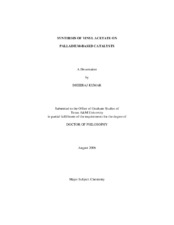| dc.description.abstract | Vinyl acetate (VA) is an important monomer used in the production of paints, surface
coatings and adhesives. Synthesis of VA is usually carried out over supported Pd alloy catalysts
with a selectivity as high as 96% and described as
C2H4 + CH3COOH + ½ O2 -> C2H3OOCCH3 + H2O
Although the VA synthesis reaction has been industrially carried out for many years, the
nature of the active sites and the reaction mechanism is still unclear. The goal of this study was
to acquire a fundamental understanding of the VA reaction mechanism by carrying out detailed
kinetic and spectroscopic investigations on single crystals and supported Pd catalysts, and to
detail the role of alloying in optimizing the selectivity of this important industrial reaction.
A combination of surface science techniques and kinetic measurements has been used to
address the mechanism. Supported catalysts, 1 wt% Pd/SiO2 and 5 wt% Pd/SiO2, and 1 wt% Pd-0.5 wt% Au/SiO2, were prepared by an incipient wet-impregnation method and characterized
using XRD and TEM. On Pd-only catalysts the reaction rates were found to be: Pd(100) < 5
wt% Pd/SiO2 (dpd = 4.2 nm) < 1 wt% Pd/SiO2 (dpd = 2.5 nm). Particle size-dependence of the
reaction rates is evident for the Pd-only catalysts, which suggests a degree of structure sensitivity
of the reaction. There is an increased availability of uncoordinated, edge atoms on small particles. With a Pd single crystal, fewer less-coordinated surface sites are present compared to a
comparable area on a small Pd particle on a supported Pd catalyst.
The formation of Pd carbide (PdCx) during the synthesis of VA was investigated over
Pd/SiO2 catalysts with two different Pd particle sizes, as well as over a Pd-Au/SiO2 mixed-metal
catalyst. XRD data indicate that smaller Pd particles show greater resistance to the formation of
PdCx. The alloying of Au with Pd is apparently very effective in preventing PdCx formation in
Pd-based catalysts for VA synthesis.
Addition of Au to Pd/SiO2 catalysts significantly enhances the VA formation rate and
selectivity. Infrared reflection absorption spectroscopy (IRAS) of CO on Pd/Au(100) and
Pd/Au(111) confirms the presence of Pd as isolated monomers on a Au-rich surface. A pair of
Pd monomers is the most favorable active site for the formation of VA. The spacing between the
two active isolated Pd atoms is critical and is demonstrated by the relative rates of VA formation
on Pd/Au model catalysts, i.e. Pd/Au(111) < Pd/Au(100). The role of Au is to isolate the surface
Pd atoms and thus suppress the formation of by products, CO and CO2. A pair of Pd monomers
required for VA synthesis is further confirmed by the results from model studies of Sn-Pd. | en |


